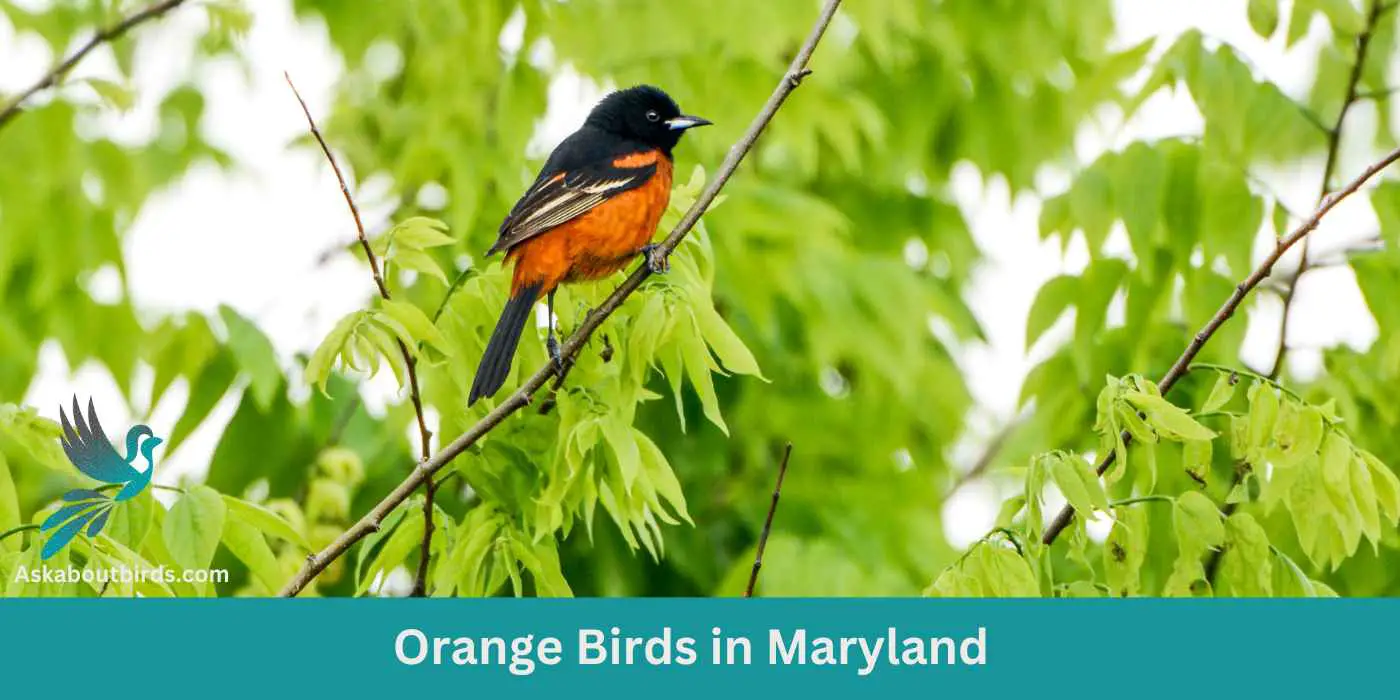Maryland, with its rich tapestry of coastal shores, dense forests, and rolling hills, is a haven for birdwatchers. Among the myriad of species that call this state home, a select group of vibrant orange birds stand out, captivating all who catch a glimpse.
Spanning from the temperate northern regions to the warmer southern parts, Maryland’s diverse climate can cater to both northern and southern bird species.
Dive into our list of 9 mesmerizing orange birds found in Maryland, and embark on a colorful journey through the state’s diverse avian wonders.
Orange Birds Found In Maryland
Maryland’s unique blend of coastal, forest, and wetland terrains creates a haven for a vibrant array of bird species. Located along the Atlantic Flyway, Maryland serves as a crucial stopover for many migrating birds, allowing birdwatchers to spot species that are merely passing through in addition to the resident birds.
Baltimore Oriole


| Feature | Measurement |
|---|---|
| Scientific Name | Icterus galbula |
| Length | 6.7–8.7 in |
| Wingspan | 9.1–12.6 in |
| Weight | 22.3-42 g |
The Baltimore Oriole is a stunning bird, best known for its vibrant coloration and its rich, whistling song.
Appearance: The male Baltimore Oriole is notable for his bright orange and black plumage and black and white wing bars, a stark contrast to the more muted yellow-brown coloration of the female. Both sexes, however, have long pointed bills and white bars on their wings.
Diet: Baltimore Orioles have a diverse diet that includes insects, fruits, and nectar. Their preference for sweet juices and fruit pulp often brings them to backyard feeders offering oranges and jelly.
Reproduction: The female Baltimore Oriole is responsible for building the distinctive hanging nest, often woven together from fine materials like hair and grass. These nests are usually high in trees to avoid predators. The female lays 3-7 eggs, which are incubated for about two weeks.
Orchard Oriole
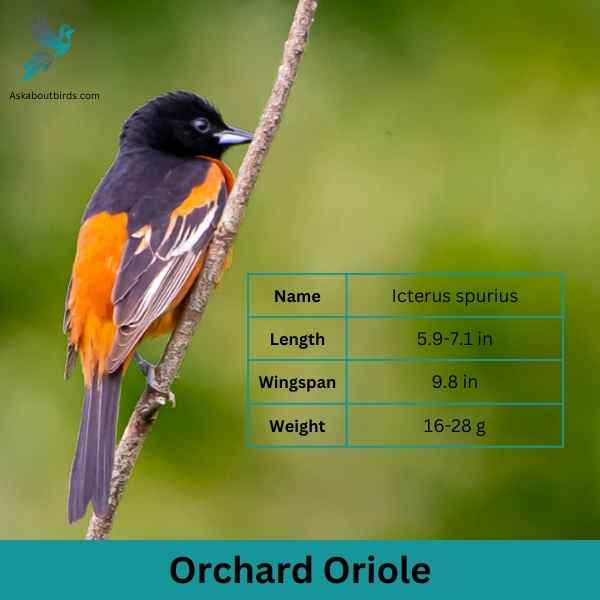
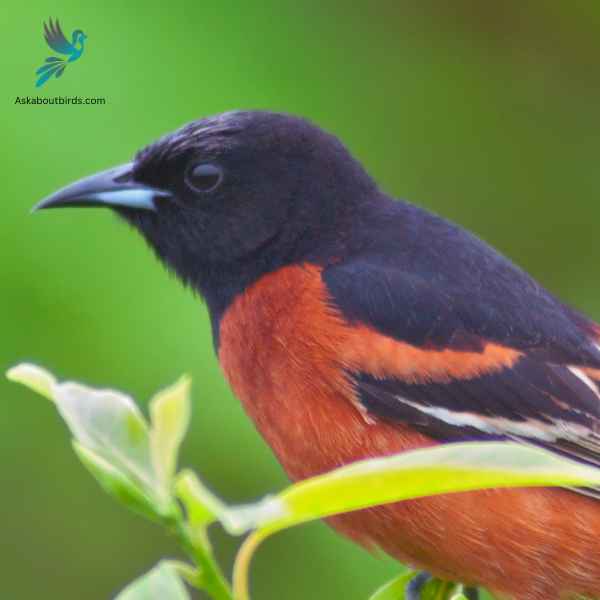
| Feature | Measurement |
|---|---|
| Scientific Name | Icterus spurius |
| Length | 5.9-7.1 in |
| Wingspan | 9.8 in |
| Weight | 16-28 g |
The Orchard Oriole is a small songbird noted for its distinctive coloration and melodic song.
Appearance: Male Orchard Orioles are a striking sight with their dark chestnut body and black head and black and white wings, while females and immature males are olive-green and feature a yellowish underpart. The species is often recognized by its slender body and pointed bill.
Diet: The diet of the Orchard Oriole consists primarily of insects, fruits, and nectar. They are adept at catching insects mid-air and are also known to sip nectar from flowers, aiding in pollination. When fruits are in season, they make up a substantial portion of the bird’s diet.
Reproduction: Orchard Orioles often nest in open woodlands and orchards, hence their name. The female is responsible for building the nest, typically choosing a location in a tree or shrub. The female lays a clutch of 4 to 6 eggs, which she incubates for about two weeks.
Scarlet Tanager


| Feature | Measurement |
|---|---|
| Scientific Name | Piranga olivacea |
| Length | 6.3 to 7.5 in |
| Wingspan | 9.8 to 11.8 in |
| Weight | 23.5 to 38 g |
The Scarlet Tanager is a strikingly colorful bird known for its brilliant plumage and distinctive song.
Appearance: Male Scarlet Tanagers are notable for their vibrant scarlet bodies contrasted with black wings and tail, making them one of the most intensely colored birds. Females and juveniles, on the other hand, have a subdued olive-yellow body color with darker wings and tail.
Diet: The diet of the Scarlet Tanager is largely made up of insects, including beetles, cicadas, aphids, and others. They are adept flycatchers, seizing insects in mid-air or picking them off foliage. They also consume fruits and berries, especially during migration and in their winter habitats.
Reproduction: The female Scarlet Tanager builds a cup-shaped nest using twigs, rootlets, and grass, typically well-hidden in the dense foliage of trees. She lays 3 to 5 eggs and incubates them for about two weeks.
American Redstart


| Feature | Measurement |
|---|---|
| Scientific Name | Setophaga ruticilla |
| Length | 4.3 to 5.5 in |
| Wingspan | 6.3 to 9.1 in |
| Weight | 8.6 g |
The American Redstart is a lively warbler known for its vivid colors and active hunting style, often seen flitting about, fanning its tail to startle and catch insects.
Appearance: Adult male American Redstarts boast striking black plumage with bright orange patches on the sides, wings, and tail. Females and immature males have grayish-olive upperparts with yellow patches in the same areas where the males display orange.
Diet: American Redstarts are primarily insectivores. They actively forage for flying insects, as well as caterpillars and spiders, often using their colorful tails to startle prey and make them easier to catch.
Reproduction: The female American Redstart builds a cup-shaped nest in the fork of a tree branch. Typically, she lays a clutch of 3 to 5 eggs. The female takes on the primary responsibility of incubating the eggs, while both parents participate in feeding the fledglings after they hatch.
Eastern Towhee

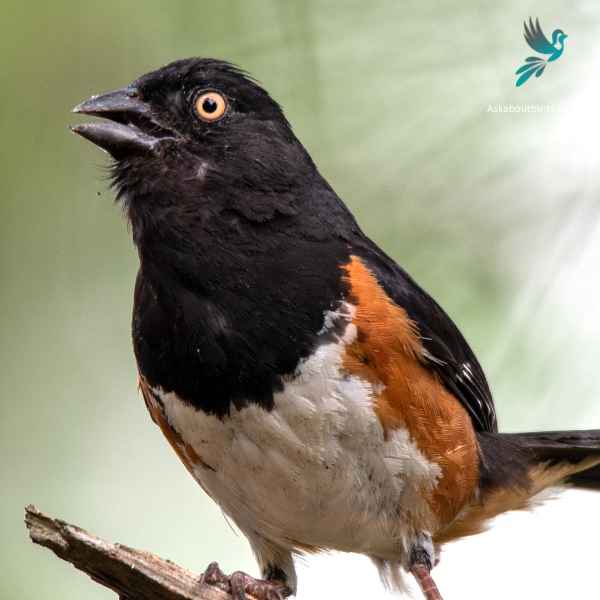
| Feature | Measurement |
|---|---|
| Scientific Name | Pipilo erythrophthalmus |
| Length | 6.8 to 9.1 in |
| Wingspan | 7.9–11.8 in |
| Weight | 32 to 53 g |
The Eastern Towhee is a distinctive songbird known for its unique calls and eye-catching coloration.
Appearance: Male Eastern Towhees are characterized by a striking combination of a black head, back and tail, contrasting with a white belly and rufous flanks. Females sport similar patterns but instead of black, they have a rich brown color. Both genders have red eyes, lending a special charm to their overall appearance.
Diet: Eastern Towhees primarily feed on a variety of insects, seeds, and berries. Their diet is quite diverse, taking advantage of seasonal offerings, which includes beetles, caterpillars, spiders, acorns, grass seeds, and various fruits and berries.
Reproduction: Eastern Towhees build their nests on or near the ground, often in a shrub or a small tree. The female lays around 3-5 eggs and takes the primary role in incubating them over about 12-13 days.
Northern Flicker

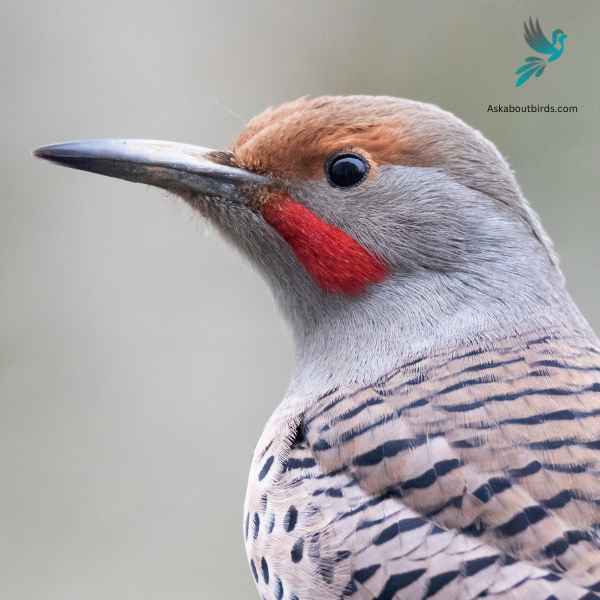
| Feature | Measurement |
|---|---|
| Scientific Name | Colaptes auratus |
| Length | 11–12 in |
| Wingspan | 17–20 in |
| Weight | 3.9–5.6 oz |
The Northern Flicker is a medium-sized woodpecker, recognized by its unique patterns and coloring, often found drumming on trees or foraging on the ground across North America.
Appearance: The Northern Flicker stands out with its grayish brown body, black-scalloped plumage, and a black bib. Males sport a distinctive black or red mustache stripe. Depending on the subspecies, the underwing and undertail feathers can be bright yellow or red, flashing vividly during flight.
Diet: While most woodpeckers are tree-bark foragers, the Northern Flicker prefers hunting on the ground. Its primary diet consists of ants and beetles, supplemented occasionally by fruits, berries, seeds, and other small insects.
Reproduction: Northern Flickers are cavity nesters, preferring to excavate their nesting hole in dead or diseased tree trunks. The interior of the nest is lined with wood chips.
Red Crossbill

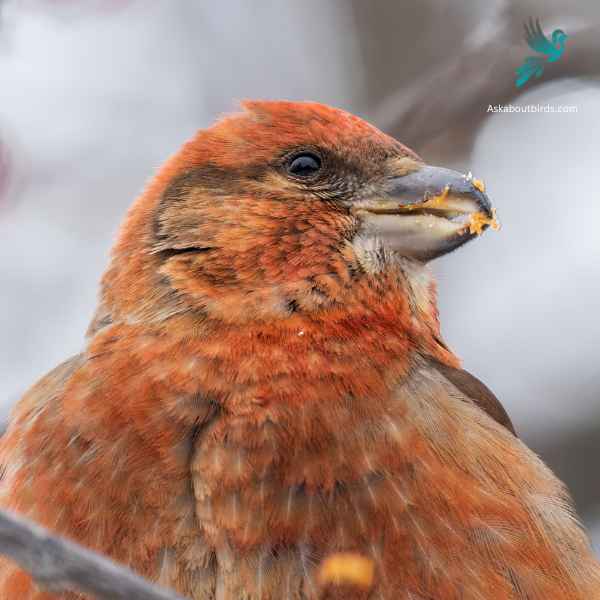
| Feature | Measurement |
|---|---|
| Scientific Name | Loxia curvirostra |
| Length | 5.5–7.5 in |
| Wingspan | 9.8–10.6 in |
| Weight | 0.9–1.4 oz |
The Red Crossbill is a distinctive finch known for its unusual bill, which has evolved to extract seeds from conifer cones.
Appearance: Males are typically bright red or orange, while females are greenish-yellow or olive. Both genders have the characteristic crossed bill, which they use to expertly extract seeds from tightly closed conifer cones.
Diet: Red Crossbills primarily feed on the seeds of coniferous trees, such as spruce, pine, and fir. Their specialized bills allow them to efficiently pry apart conifer cone scales to access the seeds.
Reproduction: Red Crossbills are somewhat nomadic and don’t adhere to a strict breeding schedule. Instead, they breed whenever and wherever food is abundant. Their nests are usually built on horizontal branches of conifer trees.
American Robins


| Feature | Measurement |
|---|---|
| Scientific Name | Leptotila plumbeicep |
| Length | 10.6-11.8 in |
| Wingspan | — |
| Weight | 160-200 g |
The American Robin is a widely recognized bird species known for its melodious song and early bird tendencies.
Appearance: American Robins are medium-sized birds with a distinctive appearance. Both males and females sport a gray to brown back and a warm red to orange breast and belly and gray wings. They also have a characteristic white eye-ring and a black head, but males are usually darker than females.
Diet: American Robins have a diverse diet that changes depending on the season. In summer, they feed heavily on earthworms, beetles, and other invertebrates, which they catch on the ground. During winter, they mostly eat fruits and berries.
Reproduction: American Robins usually build their nests in trees or shrubs, but they are also known to nest on human-made structures. The female lays a clutch of about 3 to 5 eggs, which she incubates for about 12 to 14 days.
Summer Tanager


| Feature | Measurement |
|---|---|
| Scientific Name | Piranga rubra |
| Length | 6.7 in |
| Wingspan | 28 to 30 cm |
| Weight | 29 g |
The Summer Tanager is a medium-sized songbird admired for its radiant plumage and melodious song.
Appearance: Male Summer Tanagers are an impressive bright red, while females and juveniles present a softer, yellow-orange color. Both genders have a large, slightly hooked bill and relatively short tail.
Diet: Summer Tanagers primarily feed on insects, including bees and wasps, which they catch in flight or pick off vegetation. They are also known to eat fruits and berries, making them helpful in controlling pest populations and seed dispersal.
Reproduction: The female Summer Tanager builds a loose, shallow cup-shaped nest out of twigs and grass, usually hidden in the foliage of trees. The female typically lays 3-5 eggs, which she will incubate for about two weeks.
Where to Spot Maryland’s Orange Birds
Maryland’s diverse landscapes, from the serene Chesapeake Bay to its lush forests, offer birdwatchers a paradise of avian wonders. Here are the top locations in the state renowned for their bird diversity:
- Blackwater National Wildlife Refuge: Located near Cambridge, this refuge provides a haven for thousands of waterfowl, especially during migration seasons. Its expansive marshlands are also home to the iconic Bald Eagles and the rare Delmarva fox squirrel.
- Assateague Island National Seashore: A barrier island boasting a mix of beach, dune, forest, and salt marsh habitats, Assateague is famous for its wild ponies and diverse bird species, including many shorebirds and raptors. Look for the Prothonotary Warbler and the Yellow Warbler in Maryland migrate from South America during certain seasons.
- Catoctin Mountain Park: Situated near Thurmont, this upland hardwood forest habitat is a prime location to spot warblers, thrushes, and woodpeckers, especially during spring and fall migrations.
- Patuxent Research Refuge: Established to support wildlife research, this refuge in Laurel offers a mix of deciduous and evergreen forests, wetlands, and meadows, making it a hotspot for songbirds, waterfowl, and raptors.
- Hart-Miller Island State Park: Located in Chesapeake Bay, this island is a top destination for spotting shorebirds, terns, and waterfowl, especially during the spring and fall migrations. The island’s diverse habitats offer shelter and food for many avian species.
| State’s Orange Birds | Best Spots for Orange Birds |
|---|---|
| Delaware’s Orange Birds | Bombay Hook National Wildlife Refuge, Prime Hook National Wildlife Refuge, Cape Henlopen State Park |
| Pennsylvania’s Orange Birds | Hawk Mountain Sanctuary, Presque Isle State Park, John Heinz National Wildlife Refuge |
| Virginia’s Orange Birds | Shenandoah National Park, Chincoteague National Wildlife Refuge, Great Dismal Swamp NWR |
| West Virginia’s Orange Birds | Canaan Valley National Wildlife Refuge, New River Gorge National Park and Preserve, Monongahela National Forest |
FAQs on Orange Bird Species Found in Maryland
Which birds with bright orange plumage are often spotted in Maryland’s backyard feeders?
Bird watchers in Maryland often get treated to sightings of the Eastern Bluebird, especially near deciduous trees and open woods. With its brilliant red-orange plumage on the chest contrasting against blue-gray wings, it’s a favorite among bird enthusiasts. These birds are particularly attracted to sunflower seeds and ripe fruit, such as crab apples, making bird feeders stocked with these a popular spot for them.
What do common backyard birds with orange sides prefer to eat in Maryland?
Common backyard birds in Maryland, like the House Finch with its vibrant orange sides and the Eastern Bluebird, primarily eat seeds, ripe fruit, and insects. Bird feeders stocked with sunflower seeds, grape jelly, and sugar water can attract these birds. During breeding plumage, the bright orange colors become even more vibrant, especially when they’re hunting insects among the leaf litter and tall trees of Maryland’s deciduous forests.
Where in Maryland can one find the best bird watching spots for orange-plumaged birds?
Maryland’s forest edges, deciduous trees, shade trees, and open woods are prime habitats for bird watching, especially for spotting birds with orange plumage. These habitats offer ample breeding habitat, tree cavities, and feeding opportunities, attracting a diverse range of birds, including the Eastern Bluebird and the House Finch.
Are there any historical or national references to the bright-colored birds of Maryland?
Absolutely! The Northern Cardinal, with its brilliant red coloring resembling Lord Baltimore’s coat, is a majestic bird that holds significance in Maryland’s history. Not only is it one of the most common backyard birds, but its vibrant colors and tuneful songs make it a favorite among locals and bird enthusiasts alike. They’re often found in deciduous forests and tall trees, seeking seeds and small insects to feed on.

